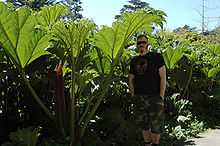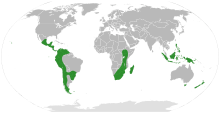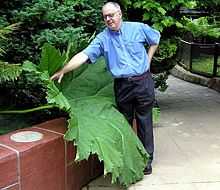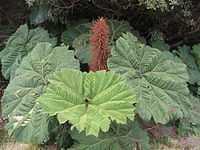Gunnera
| Gunnera | |
|---|---|
 | |
| Gunnera tinctoria at the San Francisco Botanical Garden at Strybing Arboretum | |
| Scientific classification | |
| Kingdom: | Plantae |
| (unranked): | Angiosperms |
| (unranked): | Eudicots |
| (unranked): | Core eudicots |
| Order: | Gunnerales |
| Family: | Gunneraceae |
| Genus: | Gunnera L. |
 | |
| The range of the genus Gunnera[1] | |
| Synonyms[2] | |
| |
Gunnera is a genus of herbaceous flowering plants, some of them grow extremely large. The genus is the only member of the family Gunneraceae. It is native to Latin America, Australia, New Zealand, Papuasia, Hawaii, insular Southeast Asia, Africa, and Madagascar.[2]
Description
The 40–50 species vary enormously in leaf size. Gunnera manicata, native to the Serra do Mar mountains of southeastern Brazil, is perhaps the largest species, with leaves typically 1.5–2 m (5–6 ft) wide, but exceptionally long, up to 3.4 m (11 ft), borne on thick, succulent leaf stalks (petioles) up to 2.5 m (8 ft) long. It germinates best in very moist, but not wet, conditions and temperatures of 22–29 °C.
Only slightly smaller is G. masafuerae of the Juan Fernandez Islands off the Chilean coast. They can have leaves up to 2.9 m (9 ft 5 inches) in width on stout leaf stalks 1.5 m (5 ft) long and 11 cm (4.5 in) thick according to Skottsberg. On nearby Isla Más Afuera, G. peltata frequently has an upright trunk to 5.5 m (18 ft) in height by 25–30 cm (10–12 in) thick, bearing leaves up to 2 m (6 ft 4 inches) wide. G. magnifica of the Colombian Andes bears the largest leaf buds of any plant; up to 60 cm (2 ft) long and 40 cm (16 inches) thick. The succulent leaf stalks are up to 2.7 m (8 ft 10 inches) long. The massive inflorescence of small, reddish flowers is up to 2.3 m (7 ft 6 inches) long and weighs about 13 kg. Other giant Gunnera species are found throughout the Neotropics and Hawaii.
Several small species are found in New Zealand, notably G. albocarpa, with leaves only 1–2 cm long, and also in South America, with G. magellanica having leaves 5–9 cm wide on stalks 8–15 cm long.


This genus was named after the Norwegian botanist Johann Ernst Gunnerus.
- Species[2]
- Gunnera aequatoriensis - Ecuador
- Gunnera albocarpa - New Zealand
- Gunnera annae - Peru, Bolivia
- Gunnera antioquensis L.E.Mora - Colombia
- Gunnera apiculata - Bolivia, Argentina
- Gunnera arenaria - New Zealand
- Gunnera atropurpurea - Colombia, Ecuador
- Gunnera berteroi - Bolivia, Argentina, Chile
- Gunnera bogotana - Colombia
- Gunnera bolivari - Peru, Ecuador
- Gunnera bracteata - Robinson Crusoe Island in Chile
- Gunnera brephogea - Colombia, Ecuador, Peru
- Gunnera caucana - Colombia
- Gunnera colombiana - Colombia, Ecuador
- Gunnera cordifolia - Tasmania
- Gunnera cuatrecasasii - Colombia
- Gunnera densiflora - New Zealand
- Gunnera dentata - New Zealand
- Gunnera diazii - Colombia
- Gunnera flavida - New Zealand
- Gunnera garciae-barrigae - Colombia
- Gunnera hamiltonii - New Zealand
- Gunnera hernandezii - Colombia
- Gunnera herteri Osten - Uruguay, S Brazil
- Gunnera insignis - Panama, Nicaragua, Costa Rica
- Gunnera kauaiensis - Kauai in Hawaii
- Gunnera killipiana - Chiapas, Guatemala, Honduras
- Gunnera lobata - Tierra del Fuego
- Gunnera lozanoi - Colombia
- Gunnera macrophylla - Papuasia, Indonesia, Philippines
- Gunnera magellanica - W + S South America, Falkland Is.
- Gunnera magnifica - Colombia
- Gunnera manicata - S Brazil
- Gunnera margaretae - Peru, Bolivia
- Gunnera masafuerae - Alejandro Selkirk Island (Isla Mas Afuera) in Chile
- Gunnera mexicana - Veracruz, Chiapas
- Gunnera mixta - New Zealand
- Gunnera monoica - New Zealand incl Chatham Islands
- Gunnera morae - Colombia
- Gunnera peltata - Robinson Crusoe Island in Chile
- Gunnera perpensa - Africa, Madagascar
- Gunnera peruviana - Ecuador, Peru
- Gunnera petaloidea - Hawaii
- Gunnera pilosa - Peru, Bolivia, Ecuador
- Gunnera pittieriana - Venezuela
- Gunnera prorepens- New Zealand
- Gunnera quitoensis - Ecuador
- Gunnera reniformis - New Guinea
- Gunnera saint-johnii - Colombia
- Gunnera sanctae-marthae - Colombia
- Gunnera schindleri - Bolivia, Argentina
- Gunnera schultesii - Colombia
- Gunnera silvioana - Ecuador, Colombia
- Gunnera steyermarkii - Venezuela
- Gunnera strigosa- New Zealand
- Gunnera tacueyana - Colombia
- Gunnera tajumbina - Ecuador, Colombia
- Gunnera talamancana - Costa Rica, Panama
- Gunnera tamanensis - Colombia
- Gunnera tayrona - Colombia
- Gunnera tinctoria - Chile, Argentina
- Gunnera venezolana - Venezuela
Cyanobacterial symbiosis
In nature, all Gunnera plants form a symbiosis with nitrogen-fixing cyanobacteria, thought to be exclusively Nostoc punctiforme. The bacteria enter the plant via glands found at the base of each leaf stalk[1] and initiate an intracellular symbiosis which is thought to provide the plant with fixed nitrogen in return for fixed carbon for the bacterium. This intracellular interaction is unique in flowering plants and may provide insights to allow the creation of novel symbioses between crop plants and cyanobacteria, allowing growth in areas lacking fixed nitrogen in the soil.
Uses
The stalks of G. tinctoria (nalcas), from Southern Chile and Argentina, are edible. Their principal use is fresh consumption, but also they are prepared in salads, liquor or marmalade. Leaves of this species are used in covering curanto (a traditional Chilean food).
Gunnera perpensa is used as a source of traditional medicine in Southern Africa.
References
- ↑ 1.0 1.1 Bergman, B.; Johansson, C.; Söderbäck, E. (1992). "The Nostoc–Gunnera symbiosis". New Phytologist 122 (3): 379. doi:10.1111/j.1469-8137.1992.tb00067.x.
- ↑ 2.0 2.1 2.2 Kew World Checklist of Selected Plant Families
External links
- The Gunnera Gallery
- Gunnera magellanica pictures from Chilebosque
- Global Invasive Species database Gunnera tinctoria
- Medicinal plant details Gunnera perpensa
- Gunnera on Achill Island